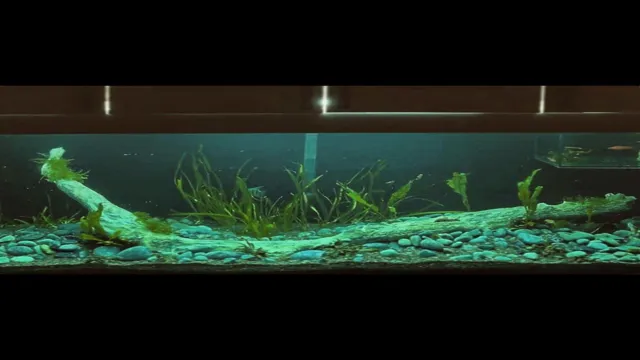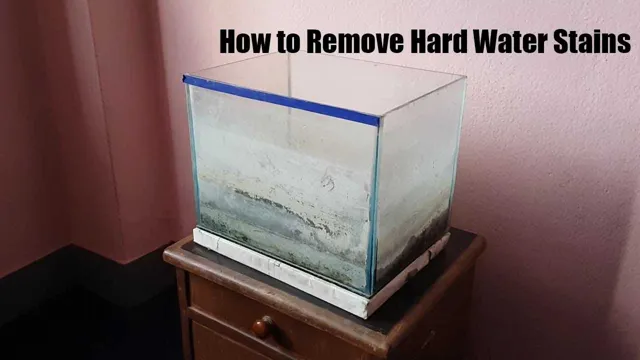How to Achieve 4-6 Water Hardness in Aquarium: Tips and Tricks
Dealing with the hardness of water can be a challenge when it comes to maintaining the perfect environment for your thriving aquarium. Excessive hardness in your water can lead to devastating effects on your aquatic life, including disease, ill-health, and even death. Therefore, it is essential to keep your water hardness level in check.
As a general rule, most aquariums should aim for 4-6 degrees of water hardness. The water hardness level in your aquarium is directly proportional to the minerals present in it. Therefore, it is essential to understand the water composition and factors that impact it, including pH, alkalinity, and mineral concentrations.
Too much of these factors can lead to increased water hardness, causing harm to your aquatic life. Whereas, too little of these factors can cause your water to be too soft, also creating negative impacts. Achieving the desired 4-6 hardness level in your aquarium requires careful attention to its water parameters, plant life, and livestock.
Several ways are achieving the recommended hardness level include water filtration, water conditioners, regular testing with pH and KH tests, and adding supplements to maintain mineral balances. Having the right water hardness level is critical to ensure the survival and well-being of your aquarium’s inhabitants. Therefore achieving the recommended 4-6 hardness level should be a top priority for any aquarium enthusiast.
By taking care of the water quality and maintaining the perfect balance, your aquatic life will thrive, creating a beautiful and healthy aquarium.
Understanding Water Hardness
If you’re wondering how to achieve a water hardness range of 4-6 in your aquarium, it’s important to first understand what water hardness is. Water hardness refers to the amount of dissolved minerals, particularly calcium and magnesium, present in the water. The ideal water hardness range for most aquarium fish is between 4-6 dH (German degrees hardness).
One way to achieve this is by using reverse osmosis (RO) water and adding in a remineralizer to reach the desired hardness level. Another option is to mix tap water with RO water to achieve the desired hardness, but this can vary based on your local water supply. It’s important to regularly test and monitor your water hardness to ensure a stable and healthy environment for your aquarium inhabitants.
What is Water Hardness?
Water hardness refers to the level of mineral content in water, particularly the amount of calcium and magnesium ions present. These minerals are essential for human health and are important for maintaining strong bones and teeth. However, high levels of these minerals in water can create problems for our home appliances and plumbing systems, leading to sediment buildup and eventual damages.
If you’ve ever noticed water spots on your glasses or dishes, or a lack of suds while washing clothes, you might be dealing with hard water. Water hardness is measured in grains per gallon (GPG), with anything above 10 GPG considered hard water. It can be treated using a water softener or by installing a reverse osmosis system.
Understanding the level of water hardness in your home water supply is essential for ensuring the longevity of your appliances and protecting the health of your family.

What Causes Water Hardness?
Water hardness occurs when there are high levels of dissolved minerals, particularly calcium and magnesium, in the water. The minerals originate from underground sources and are picked up as the water travels through soil and rock formations. Hard water can cause scale buildup in pipes, appliances, and fixtures, which can eventually lead to clogs and damage.
It can also make soap less effective and leave residue on dishes and clothing. Additionally, hard water can cause skin irritation and make hair feel dull and brittle. The best way to address water hardness is by using a water softener, which removes the minerals through an ion exchange process.
By removing the minerals, water softeners prevent scale buildup and extend the lifespan of appliances.
Measuring Water Hardness
Water hardness, while often overlooked, is an essential factor in determining water quality. Water hardness is a measure of the concentration of calcium and magnesium ions in the water. These ions can build up over time in your pipes, appliances, and even dishes, causing damage and reducing the efficiency of your water system.
Measuring water hardness can be done in several ways, including using test strips or sending a sample to a lab. Once you have determined the water hardness level, you can take steps to alleviate any negative effects it may be having on your system. This might include installing a water softener or using a descaling agent.
By understanding water hardness, you can ensure that your water system remains efficient and effective for years to come.
Methods for Achieving 4-6 Water Hardness
If you’re looking to achieve 4-6 water hardness in your aquarium, there are a few methods you can try. One option is to use a buffering agent like crushed coral or limestone in your filter. These materials will release minerals into the water, raising its hardness level.
Another option is to add specific minerals like calcium and magnesium to the water directly. You can do this using commercial supplements or by adding natural sources like dried leaves or rocks to the tank. Keep in mind that achieving consistent water hardness levels requires regular testing and monitoring.
It’s also important to slowly adjust the water chemistry to avoid shock and stress for your aquatic pets. By taking these steps, you can create the optimal environment for your aquarium inhabitants and support their health and wellbeing.
Add Minerals like Calcium and Magnesium
If you’re looking to achieve a water hardness level of 4-6, adding minerals like calcium and magnesium can be a game-changer. One way to add these minerals is through the use of supplements that are specifically designed for water. These supplements can increase the overall hardness of your water, helping to reduce corrosion and improve the taste of the water.
Another option is to install a water softener that uses ion exchange to remove minerals like calcium and magnesium and replace them with sodium or potassium. While this method can be effective, it may not be the best option for those who are sodium or potassium-sensitive. Regardless of the method, it’s important to note that achieving a water hardness level of 4-6 may not be necessary for everyone.
It’s important to consider the specific needs of your household and whether or not a higher or lower water hardness level would be more appropriate. Ultimately, adding minerals like calcium and magnesium can be a simple and effective way to achieve the desired water hardness level and improve the overall quality of your water.
Use a Water Softener Pillow
One effective method for achieving water with a hardness level of 4-6 is to use a water softener pillow. These compact and easy-to-use pillows contain special resins that work to remove excess minerals such as calcium and magnesium from your tap water, leaving it softer and more enjoyable to use. Simply add the pillow to your water filtration system or drop it directly into your water source to start noticing an immediate difference in the quality and overall feel of your water.
Not only is this method easy and affordable, but it also helps to protect your plumbing and appliances from damage caused by hard water. So if you’re looking for a quick and effective solution for achieving optimal water hardness levels, look no further than a reliable water softener pillow.
Use Distilled or RO Water
If you’re a homebrewer or just enjoy drinking better-tasting coffee, achieving the right water hardness level is essential. One way to get your water to a hardness level of 4-6 is to use distilled or reverse osmosis (RO) water. Distilled water is purified by boiling it and condensing the steam, effectively removing any impurities, including minerals.
RO water, on the other hand, is filtered through a semipermeable membrane to remove impurities, minerals, and contaminants. Both methods result in water with significantly reduced mineral content, which is great for brewing coffee since it won’t interfere with the natural flavors and aromas of your beans. Keep in mind that this mineral-free water may be too aggressive for other brewing methods, such as espresso.
In that case, you can add minerals back in using specialty water treatment sachets to achieve the perfect balance for your brew.
Mix Tap Water with Distilled or RO Water
If you’re struggling to achieve the ideal water hardness of 4-6 for your aquarium, mixing tap water with distilled or RO water could be the perfect solution. Tap water contains minerals that can often result in high levels of water hardness, making it unsuitable for many fish species. By mixing it with distilled or RO water, you can dilute these minerals and lower the overall hardness of the water.
The best way to achieve the perfect balance is by testing the water regularly and adjusting the ratios of tap and distilled/RO water as necessary. It may take some trial and error to find the perfect balance, but this method is a cost-effective way to achieve optimal water hardness for your aquarium inhabitants. Don’t forget to use an aquarium water conditioner to neutralize any chlorine or chloramines in your tap water before adding it to your tank.
With a little patience and experimentation, you can create the perfect environment for your aquatic pets.
Maintaining 4-6 Water Hardness
Achieving a water hardness level of 4-6 in an aquarium can be a bit of a challenge, but it’s definitely achievable. One of the easiest ways to achieve this is by using a mix of reverse osmosis (RO) water and tap water. RO water has a very low hardness level, so mixing it with tap water can create the ideal hardness level.
You can also use chemical treatments to adjust the hardness level of your water. Adding seashells, limestone, or crushed coral to your aquarium can also work well. These materials will release calcium and other minerals into the water, increasing the hardness level.
Always monitor and test the water regularly to ensure that the hardness level is consistent and ideal for your fish and plants. With a little bit of effort and patience, you can achieve the perfect water hardness level for your aquarium.
Regular Water Testing
Regular water testing is essential to maintain 4-6 water hardness, which is the ideal range for safe and healthy water consumption. Hard water can cause a range of issues, from damaging pipes and appliances to leaving unsightly stains on surfaces. By regularly testing your water, you can ensure that it falls within the recommended range and take corrective action if necessary.
A simple water testing kit can be purchased at your local hardware store and is easy to use. Testing your water regularly not only benefits your health and home, but it also provides peace of mind that your water is safe and healthy. So, don’t neglect water testing.
Keep your water at optimal hardness and enjoy clean, clear, and healthy water for you and your loved ones.
Add Minerals as Needed
If you’re keeping fish in a home aquarium, maintaining the correct water hardness is essential for their health and well-being. Most freshwater fish species prefer a water hardness level of 4-6 dGH, which means that the water contains enough minerals like calcium and magnesium for them to thrive. However, if your water supply is naturally soft or you’re using a water purification system that removes minerals, you may need to add supplements to achieve this level of hardness.
Adding crushed coral, limestone, or shells to your aquarium can slowly release these minerals over time and stabilize your water hardness. It’s essential to monitor your water hardness levels regularly and adjust the supplements as needed, as too much mineralization can harm your fish. By keeping your aquarium water at the optimal hardness level, you can ensure that your fish remain healthy and happy.
Proper Tank Maintenance
When it comes to maintaining a healthy and happy tank, the hardness of the water is an essential factor. Generally, a water hardness of 4-6 dGH is ideal for most aquariums. But how do we ensure that our tank’s water stays within this range? Regular water testing is critical, as the hardness can fluctuate with time.
It’s also crucial to clean your tank regularly, as the build-up of debris can impact the water’s hardness. Filters and water conditioners can help keep the water’s mineral content optimal, which is especially important for softer water. By staying on top of your tank’s maintenance and keeping an eye on water hardness levels, you can help create a healthy and thriving ecosystem for your aquatic pets.
Conclusion
If you’re looking to achieve a water hardness of 4-6 in your aquarium, it’s important to remember that there’s no getting around the fact that water chemistry can be a finicky thing. However, with some careful planning and attention to detail, it is absolutely achievable. Start by investing in a reliable water testing kit, so you can keep tabs on your water hardness and adjust your treatment plan accordingly.
Then, consider adding in some natural methods for increasing hardness, like using crushed coral or adding in mineral-rich rocks. And remember, patience is key. Like any process worth its salt (or calcium, in this case), it may take some time to perfect your setup, but the payoff will be worth it when you finally achieve that perfect water hardness level for your finned friends.
“
FAQs
What is the ideal water hardness for keeping aquarium fish?
The ideal water hardness for keeping aquarium fish is generally between 4 and 6.
How can I achieve 4-6 water hardness in my aquarium?
You can achieve 4-6 water hardness in your aquarium by using a water softener or adding aquarium-safe products to reduce the hardness.
Can I use tap water to achieve 4-6 water hardness in my aquarium?
If your tap water is already within the ideal hardness range, then yes, you can use tap water. However, if your tap water is harder than 6, then you will need to soften it before adding it to the aquarium.
What types of fish prefer 4-6 water hardness?
Fish that prefer 4-6 water hardness include tetras, rasboras, and some cichlids.
Can I test the water hardness in my aquarium?
Yes, you can test the water hardness in your aquarium using a water hardness testing kit.
How often should I check the water hardness in my aquarium?
It is recommended to check the water hardness in your aquarium at least once a month.
What are the dangers of having water hardness outside of the ideal range in an aquarium?
Having water hardness outside of the ideal range in an aquarium can lead to health issues for the fish, as well as problems with equipment and plant growth.






